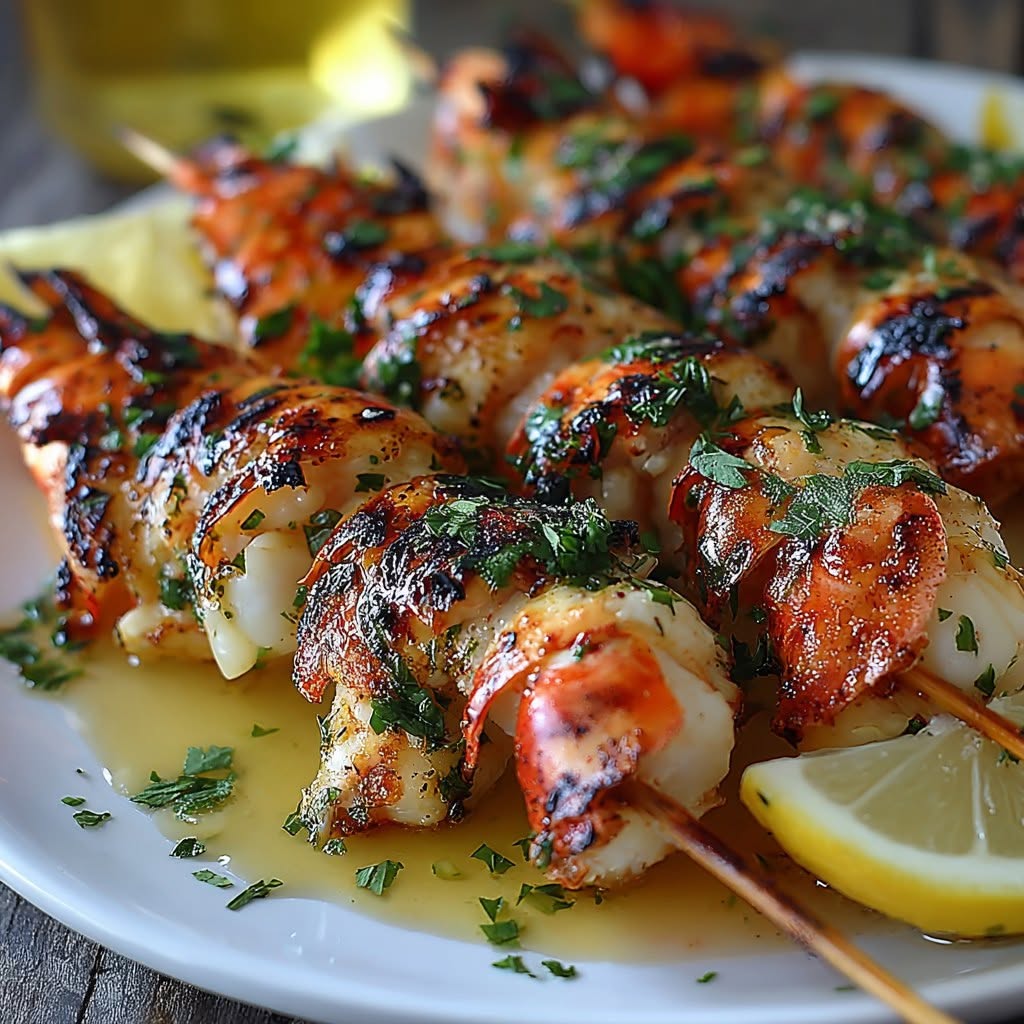Drunken Lobster Tail Skewers: A Sumptuous Grill Delight
If you are looking to elevate your grilling game, Drunken Lobster Tail Skewers might just be the exotic dish you need. With a fusion of succulent lobster and a tangy marinade infused with wine, these skewers ooze elegance and flavor. Perfect for those summer evenings or a special occasion, this recipe combines tradition with a modern twist to wow your guests and satisfy the taste buds.
Lobster tails are marinated in a mixture that brings out the natural sweetness of the seafood while subtly enhancing it with wine and spices. The grilling process imparts a delightful char and smokiness, creating a dish that is not just a meal, but an experience. The combination of flavors will transport you to a beachside setting, even if you’re grilling from your backyard.
Quick Recipe Highlights
- Flavor Profile: The taste is a perfect balance between the sweetness of lobster and the subtle kick from the wine marinade, with notes of garlic and herbs adding depth.
- Texture: Expect tender, juicy lobster with a slight charred crust that enhances the overall mouthfeel, making each bite a delightful experience.
- Aroma: The cooking process releases an enticing aroma of grilled seafood mingled with herbs and a hint of wine, creating an irresistible fragrance.
- Visual Appeal: The lobster turns a lavish, golden hue during grilling, complemented by vibrant green herbs and the skewers’ fresh appearance on the plate.
- Skill Level Needed: Intermediate cooking skills are required to perfectly grill the lobster without overcooking it, ensuring the texture remains ideal.
- Special Equipment: Skewers and a grill or grill pan are essential to achieve the desired texture and flavor.
Recipe Overview
- Difficulty Level: While grilling requires some skill, this recipe is approachable for home cooks willing to learn. Mastery of lobster handling is essential.
- Category: This dish fits in both main courses for a luxurious family dinner and as an exquisite starter when entertaining guests.
- Cuisine: Drawing inspiration from coastal cuisines worldwide, the recipe merges traditional grilling with innovative marinading techniques.
- Cost: Lobster may lean on the pricier side, yet the dish’s sophistication offers a worthwhile gastronomic investment, ideal for special occasions.
- Season: Best enjoyed during the warm summer months or during festive family gatherings to make the most of the grilling season.
- Occasion: Perfect for outdoor gatherings, festive celebrations, or intimate dinners where a touch of elegance is desired.
Why You’ll Love This Recipe
The Drunken Lobster Tail Skewers are a celebration of taste and texture, with the lobster’s sweetness perfectly balanced by the marinade’s punch. Each bite is juicy, tender, and slightly smoky from the grilling process, a sensation that sets this dish apart from typical grilled seafood recipes. Your palate will dance with the complex, yet harmonious flavors.
Preparation is surprisingly straightforward, allowing you to focus on technique rather than complex steps. Marinating the lobster requires only a few minutes, and grilling is quick, offering a tasty result with minimal fuss. This makes the recipe both convenient for cooks with tight schedules and optimal for last-minute celebrations.
Lobster is a lean protein packed with essential nutrients like omega-3 fatty acids and vitamins, adding a health-conscious element to this indulgent meal. With quality wine and fresh ingredients, it becomes more than just a treat; it’s a nutritious delicacy.
Entertaining is where Drunken Lobster Tail Skewers truly shine. As guests savor the novel combination of flavors, you’re sure to receive your fair share of compliments for both the taste and the elegance of the presentation. Pair these skewers with light sides, and you have an effortlessly fancy meal.
Cost-effectiveness is enhanced by the minimal additional ingredients required beyond the lobster itself. Ingredients like wine, garlic, and herbs are common pantry staples, making this a financially accessible option despite lobster’s luxury status.
Historical Background and Cultural Significance
Lobster has a storied history as a delicacy, famously revered in coastal cultures from North America to the Mediterranean. Initially regarded as a humble food for coastal communities, its reputation transformed over centuries, now symbolizing opulence and refinement. Grilling seafood is a millennia-old tradition that enhances natural flavors and hails from societies where seafood played a central role in the diet.
The Drunken Lobster Tail Skewers embody a modern culinary evolution, borrowing from age-old techniques while integrating contemporary flavor profiles inspired by global kitchens. Wine, often used to tenderize and infuse meats with flavor across various cuisines, complements lobster in a captivating union.
Regional adaptations have seen this style embraced in tropical resorts, where local spices might be fused to provide a distinct spin. Additionally, food festivals often highlight similar grilled seafood creations, each reflecting cultural nuances and local ingredient availability.
The cultural significance of such dishes also continues to evolve. From simple home cookouts to gourmet dining experiences, grilling shells remains a beloved technique worldwide, celebrating both tradition and creative innovation in culinary art forms.
Ingredient Deep Dive
Lobster, the hero of this dish, boasts a regal past and present, known for its sweet, rich meat. Historically abundant in North Atlantic seas, its rise to culinary stardom transformed it from a fisherman’s staple to a premium delicacy. Wholesome and packed with nutrients, lobster is a rich source of lean protein, omega-3 fatty acids, and essential vitamins and minerals, supporting cardiovascular health and cognitive function.
Selecting the freshest lobster tails is paramount. Look for firm, translucent flesh and an oceanic aroma, steering clear of any strong odors. If fresh isn’t available, frozen tails are a viable option, provided they are properly thawed before cooking. Keep lobster cold and cooked tails on ice for short-term storage, or freeze for longer preservation.
Brining in an exquisite marinade presents the perfect opportunity to let the wine do its magic. The choice of white or dry varieties will infuse distinct flavors while tenderizing the protein. White wines with citrus notes or a hint of oak complement the subtle sweetness of lobster, enhancing its profound depth. Properly storing opened wine in a cool location helps maintain its integrity for cooking purposes.
Utilizing garlic in marinades pays homage to its culinary heritage, bringing a pungent yet sweet undertone to recipes. Incorporated since ancient times, it enriches lobster dishes and is known for cardiovascular health benefits. Fresh garlic is preferred for the most potent aroma and flavor; storing bulbs in a dry, well-ventilated place ensures longevity. For substitution, garlic powder offers a convenient alternative when fresh garlic is unavailable.
Common Mistakes to Avoid
- Overcooking the lobster tail is a frequent error; maintain vigilance on grill time to prevent tough, rubbery texture.
- Neglecting to uniformly marinate the lobster can lead to inconsistent flavor penetration, diminishing the dish’s profile.
- Forgetting to preheat the grill results in uneven cooking, leading to potential undercooking or burning.
- Using low-quality wine impacts marinade effectiveness, as its role is both flavor and tenderizer.
- Not properly cleaning the skewers beforehand may compromise the final taste with burnt residues.
- Underestimating the importance of resting time post-grilling can cause moisture loss when skewers are cut too soon.
- Applying excessive salt in the marinade overwhelms the natural sweetness of lobster, imbalancing the flavor.
- Failing to secure the lobster evenly on skewers prevents consistent grilling, risking uneven cooking.
- Forgetting to oil the grill can lead to stickiness, ruining both texture and appearance.
- Imprecision with herbs can overpower or clash with the already delicate lobster essence.
Essential Techniques
Masterful marinating is essential before grilling your lobster skewers. The marinade not only imbues flavor but also tenderizes the seafood. Begin by ensuring thorough and even application to allow each piece of lobster to absorb the mixture’s depth. A marinating window of 15-30 minutes is ideal, offering sufficient time for flavors to integrate sans excessive acid breakdown of meat.
Grilling the skewers properly dictates the recipe’s success. High heat is essential for a sear that locks in juices while creating a delectable crust. Ensure your grill is preheated; allow the skewers to cook without immediate disturbance, flipping them only once. Watch for an internal temperature of 140°F—this signals perfectly cooked lobster.
Monitoring how the lobsters are threaded on skewers ensures even cooking. Proper twisting and spacing along the skewer help achieve this balance. Equally important is control over the cooking aggression, recognizing that direct open flames might char the exterior faster than the interior cooks. Envision signs of readiness—firm flesh texture and a uniformly opulent color.
Pro Tips for Perfect Drunken Lobster Tail Skewers
- Choose lobster tails with a slightly translucent appearance; darker-toned shells often indicate older, tough meat.
- Consider wood or stainless steel skewers; wood adds a subtle fragrance to grilling but must be soaked to avoid burning.
- A touch of lemon zest in the marinade heightens the freshness factor and counterbalances any excessive heat.
- Pairing grilled vegetables on alternate skewers celebrates seasonal bounty while offering textural contrast.
- Drizzle a light buttery sauce infused with herbs post-grilling to gloss the lobster with additional moisture and shine.
- Implement staggered cooking for smaller lobster pieces to ensure uniform doneness.
- A quick lemon spritz after grilling can enhance and brighten overall flavors, adding zestful highlights.
- Using a basting brush during grilling ensures even application of additional marinade as the skewers develop their final form.
Variants and Adaptations
Regional Variations: Embrace local seafood variants—adjust the wine for a sake infusion to carry an Asian insinuation; saffron and citrus zest can inject Mediterranean influences.
Seasonal Adaptations: Substitute accompanying sides or vegetables seasonally to celebrate freshness and availability for a vibrant plate. Asparagus in spring and corn in summer are wonderful partners.
Dietary Modifications: Accommodate gluten intolerances by ensuring wine blends are gluten-free, and replace breaded accompaniments with non-gluten carb alternatives.
Flavor Variations: Introduce cayenne or paprika for a spicier kick, layering the marinade with heat that complements buttery lobster sweetness.
Texture Modifications: Extend marinating time cautiously and incorporate citrus to tenderize further for those desiring a melt-in-the-mouth experience.
Presentation Alternatives: Distribute lobster pieces in skewers with consistent gaps, intertwine them on fine slate platters for elegant tableau dining displays.
Serving and Presentation Guide
Grasp the opportunity to elevate the visual presentation by entwining the skewers with fresh herbs upon the plate, a visual play that evokes thoughts of nature and abundance. Plating temperature matters, as pre-warmed plates retain the dish’s warmth without excess cooling.
Garnishing with fresh microgreens and edible flowers not only brings vibrancy to the dish but adds a touch of multisensory elegance. A traditional pairing includes lightly grilled vegetables, while contemporary settings may call upon quinoa salads or herb-infused couscous.
Modern serving extends to creative stacks or layered presentations, yet at its core, simplicity in layering nurtures the lobster’s protagonistic appeal. Consider portion control when serving—one to two skewers per guest ensures the main dish shines without overshadowing accompanying sides.
Wine and Beverage Pairing
A chilled glass of Sauvignon Blanc or Chardonnay pairs harmoniously with Drunken Lobster Tail Skewers, enhancing the complex yet delicate maritime flavors. Opting for dry, citrus-forward whites complements the dish without overpowering the subtlety of the lobster.
For non-alcoholic alternatives, consider inventive mocktails utilizing homemade iced tea or citrus spritzers. These subtly refreshing elements offer a harmonious balance, cleansing the palate between bites.
If progressing the meal with tea or coffee, select gentle green teas or light roasts to maintain an elegant culinary cadence, side-stepping robustness that can occlude the smooth layered flavors on offer.
Storage and Shelf Life
Ensure the longevity of leftover skewers by properly refrigerating or freezing them. When refrigerating, place them in an airtight container, prioritizing cool conditions to maintain integrity for up to two days.
Freezing extends usability, with lobster skewers wrapped individually or stored collectively in a tightly sealed freezer bag. Reheat gently in an oven to maintain moisture—avoid microwaving as it alters texture negatively.
Seek signs of spoilage like noticeable changes in lobster color or texture, acknowledging that an altered aroma signals loss of freshness. Pinpoint freezing duration within one month to experience the fullest flavors upon reheating.
Preparation efficiency continues post-freezing; slow reheats on a low oven temperature revitalize the dish, ensuring quality remains central. Reinvigorate skewers with fresh lemon and herbs as they complete their return to the plate.
Make Ahead Strategies
Marinate lobster tails overnight for an optimal infusion of flavor, securely storing them in the refrigerator covered to prevent moisture loss. Complete skewering in advance at your convenience to streamline event-day cooking.
Incișe assembly follows upon grilling—precook any long-lasting accompaniments to permit a beeline to meal service. High-quality storage also facilitates ahead of time aromatics that retain their vigor with cold storage, releasing their vibrancy when presented.
The cascade of fresh elements dance alongside flavors, never reneging on quality contingencies. An immersion in foil post-grill enhances culmination and upheld juiciness while stabilizing heat until serving.
Logistical considerations bid favoritism to event preparation, reflecting a nurturing timeline with culinary prowess. Safeguarding the essence, however, remains paramount to success when forward-thinking on gathering delights.
Scaling Instructions
Easily halve or double this versatile recipe to accommodate your guest list size—monitor ingredient ratios, ensuring the marinade’s intention isn’t diluted or overwhelmed. Observe alterations in grill equipment, considering larger scale grills or adjustments to smaller surfaces.
Time adjustments accompany scaling: account for increased marination batches or sensory time monitoring with doubled skewers on limited grill space. Store additional lobster tails appropriately, ensuring freshness translates equally well whether serving two or twenty.
Aid scalability success through equipment consistency, ensuring temperature stability, ample preparation station space, and unwavering ingredient consistency regardless of participant numbers.
Extend pantry organization with adequate storage containers, prioritizing freshness and expedient transfer upon scaling preparation to service-ready capabilities. Progression into scaling builds on foundation efficiencies while respecting original flavor intentions.
Strong>
Print
Drunken Lobster Tail Skewers
Description
Succulent lobster tails marinated in a blend of rum and spices, grilled to perfection.
Ingredients
For the Crust:
- 4 lobster tails
- 1/2 cup dark rum
- 2 tablespoons olive oil
Instructions
1. Prepare the Crust:
- Split the lobster tails in half lengthwise and remove the meat.
- In a bowl, combine rum, olive oil, and spices. Marinate the lobster meat for 20 minutes.
- Preheat grill to medium-high heat. Skewer the lobster tails and grill for 5 minutes on each side.
Notes
You can customize the seasonings to taste.





